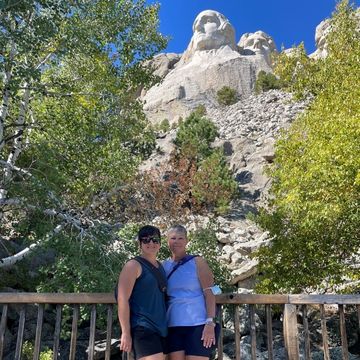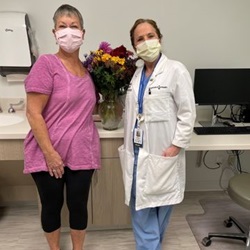Emergency Bypass Surgery Gave Karen Girard Another Chance

A typical week for retired physical education teacher Karen Girard consists of one exhilarating athletic activity after another. “I swim a mile and lift weights twice a week, I bike 7-10 miles a week, cross-country ski in the winter and walk and hike in warmer weather,” the South Hadley, MA resident says happily.
Karen considers herself fit and so when she began having trouble breathing one day, she presumed it was her asthma. Luckily, just in case it wasn’t asthma, Karen saw her primary care provider who referred her to a cardiologist to be sure the symptoms weren’t related to her heart. When Karen took the prescribed stress test, it showed abnormal heart activity. In order to diagnose the problem, the cardiologist referred Karen to Baystate Health to undergo a cardiac catheterization.
During a cardiac catheterization procedure, a very small, flexible tube (a catheter) is threaded through the large blood vessel that leads to the heart. This procedure makes it possible to measure blood flow to the heart, which allowed doctors to discover that Karen’s left, main artery was 90 percent blocked and blood was not reaching her heart as it should. Without emergency treatment, Karen would die. Baystate Health providers moved quickly and cardiac surgeon Dr. Kelly Wanamaker visited Karen while she was still in the recovery area.
“I was shocked when I heard I had coronary artery disease and needed bypass surgery,” Karen says. Her family was too.
There are many common causes for coronary artery disease including smoking, diabetes, hypertension, estrogen or lack of it and family history. According to the American Heart Association, risk factors for heart disease increase when women reach menopause, with an overall increase in heart attacks about 10 years after menopause. Researchers suspect that the lower estrogen levels may contribute to the typical high risk factors which, in Karen’s case, was high blood pressure. “Even healthy people can have coronary artery disease, although that’s less common,” Dr. Wanamaker says.
How Bypass Surgery Works
Coronary artery bypass surgery is a common type of open-heart surgery during which the surgeon creates a path for the blood to better reach the heart.
“I like to tell patients I’m similar to a plumber, but I don’t unclog pipes that are blocked, I build new pipes with the goal to restore blood flow to the heart muscle,” Dr. Wanamaker says. “I sew the vein or artery from the aorta to just beyond the blocked artery; sort of re-routing the blood.”
Once Dr. Wanamaker explained the procedure to her and everything sank in, Karen says she was scared but the next step was clear to her. “I said let’s get this done so I can get on with my life!”
The Hiking Connection
Karen appreciated how knowledgeable and professional Dr. Wanamaker was and she felt they made a connection the first time they met. After Dr. Wanamaker explained the procedure and recovery, their conversation turned to physical activity. “I told her I wanted to have the surgery done because I had a hiking trip to Yellowstone National Park planned. Dr. Wanamaker’s eyes sparkled and I knew she got me! She said she needs to move too. On days she is tired, she goes for a run! That was our connection,” Karen says. “That day I felt she knew what my needs were and that she was going to do her best to get me back on my feet and on my way to doing all of the things I love to do.”
procedure and recovery, their conversation turned to physical activity. “I told her I wanted to have the surgery done because I had a hiking trip to Yellowstone National Park planned. Dr. Wanamaker’s eyes sparkled and I knew she got me! She said she needs to move too. On days she is tired, she goes for a run! That was our connection,” Karen says. “That day I felt she knew what my needs were and that she was going to do her best to get me back on my feet and on my way to doing all of the things I love to do.”
A Heart-Stopping Success
Karen’s surgery required managing an unusual situation. The coronary vessels that Dr. Wanamaker needed to bypass were hidden deep in the heart muscle. Usually, these vessels lie on the surface of the heart. “I had to carefully locate them without causing injury. I had Karen’s heart stopped for 57 minutes to do two bypasses,” Dr. Wanamaker says.
The surgery went well and as she recovered, Karen appreciated how her care team went out of their way to make her comfortable. “I have a ton of allergies and everyone was very accommodating about meeting my needs -- from Dr. Wanamaker to the nurses and food service staff,” she says. Karen also remembers how helpful the post-op nurse was in scheduling tests after her surgery. “I felt my life was in good hands.”
From Bypasses to the Badlands
Karen made steady progress in her recovery. Within five weeks, she was able to walk briskly for an hour. In six weeks, she was biking and at nine weeks, she was back to swimming a mile twice a week.
In September, five months after surgery, Karen was thrilled she and her daughter Susan could still take the big hiking trip they’d planned before the bypass. (Due to flooding in Yellowstone National Park, they changed plans and started in Badlands National Park in South Dakota instead.) “It was such an amazing trip with my daughter!” Karen says. They also visited Mt. Rushmore, Custer State Park and several other places. “I feel great and I’m back to doing everything I love,” Karen says. After her hiking trip, Karen brought flowers to Dr Wanamaker. “I wanted to thank her for the great care and for the gift of life the way I choose to live it,” Karen says.
Yellowstone National Park, they changed plans and started in Badlands National Park in South Dakota instead.) “It was such an amazing trip with my daughter!” Karen says. They also visited Mt. Rushmore, Custer State Park and several other places. “I feel great and I’m back to doing everything I love,” Karen says. After her hiking trip, Karen brought flowers to Dr Wanamaker. “I wanted to thank her for the great care and for the gift of life the way I choose to live it,” Karen says.
Dr. Wanamaker was delighted and, with Karen’s permission, even posted a photo of herself with Karen and the flowers on LinkedIn. “It brought light to my day,” Dr. Wanamaker says. “To know she thought of me, what a sweet gesture. The best part was knowing she was hiking five months after her surgery.”
Karen says, “I always knew Baystate Medial Center was the best hospital in western Mass. Now I’ve had a chance to experience the wonderful care. Without it, I wouldn’t have been able to continue to be me.”
Learn More
Learn more about Baystate Health's lifesaving Heart & Vascular Program.

Health & Wellness Tips
Back to Top

